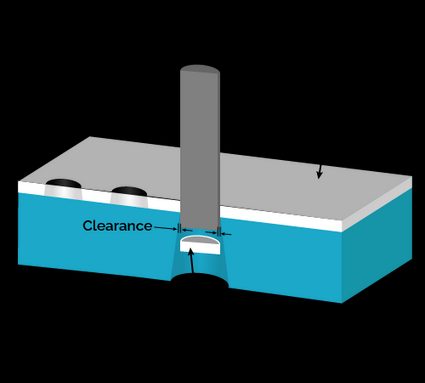Punch Force Calculator
The punch force calculator helps you determine the parameters like the thickness of the sheet and punching force for the punching process.
Metallic sheets are omnipresent in appliances like TVs, refrigerators, furnaces, automobile chassis, and auxiliary parts like washers. These sheets are often bolted together to fabricate a structure. These bolts require holes that are either drilled or punched based on the application and material specifications.
The force required to punch a hole in a sheet of material varies concerning its shear strength. Inadequate punching force can result in the wrong hole size or cracks. It is important to apply adequate pressure to obtain a dimensionally accurate hole. The calculator and the accompanying article will help you understand the punching process and how to calculate punching force for machining.
Human punch force
If you are looking for what is the average force of a human punch, head over to the human punch force calculator.
What is the punching process?
The punching process is a sheet metal forging machining operation during which the material is pressed by a punch against the die to fabricate a hole in the material. This is often a two-step process — (1) the punch is pushed halfway through the preheated workpiece, and (2) the workpiece is turned upside down and the punch is pushed completely through the workpiece to obtain a clean hole in the workpiece. The process is repeated as required to fabricate the part.
The process can be performed mechanically or using a computer numerical control (CNC) machine where the location of holes is fed into the machine using a computer program generated from CAD/CAM software. In addition, hand-operating punching machines are also available to punch through softer materials like leather, cloth, plastic, or even paper.
The punching operation works on the principle of shearing such that the force is applied on the workpiece to induce stresses greater than the material's shear strength to promote material fracture near the area of impact. The punch removes the fractured slug from the workpiece and is regarded as scrap. In some cases, the slug is not removed from the workpiece, and this process is called slugging. You can learn more about shear stresses from our shear stress calculator.

How to calculate punching force
The punching force (F) is a function of the shear strength (S), workpiece thickness (t), and the perimeter of the hole (P). You can calculate the punching force using the formula:
If the shear strength is unknown, you can estimate that using the material's tensile strength (T). The shear strength is 50-70% of the tensile strength. Such that,
Therefore, the punching force formula becomes:
Perimeter of hole
If you want to calculate perimeter first, use our perimeter calculator.
Using the punch force calculator
Let's calculate the punching to create a circular hole of perimeter 15 mm in a sheet of Al7075 having a thickness of 5 mm.
To calculate the punch force for this machining process:
-
Enter the perimeter of the hole, .
-
Fill in the thickness of workpiece, .
-
Select the material as
Al7075-T6. -
The shear strength required to punch a hole is shown as .
-
The punch force is:
FAQs
What is punch force?
The force required to create a hole in the workpiece is called the punch force. This metal forging process is used to fabricate holes in sheet metal. The applied force induces shear stress in the workpiece to remove material of the same size as the punch.
How do I calculate punch force?
To calculate punching force:
- Find the shear strength of the workpiece.
- Multiply the shear strength by the thickness of the workpiece.
- Multiply the product with the perimeter of the hole to obtain the punch force required to produce the hole.
How much punch force is required to punch a 3 mm diameter hole in 5 mm of stainless steel?
The punch force required to produce a 3 mm hole in 5 mm thick stainless steel is 18.84 kN.
First, we calculate the perimeter of the hole using its diameter, π × 3 = 9.42 mm.
Then, considering the shear strength of stainless steel as 400 MPa, the punch force calculation is:
F = 400 × 9.42 × 5 = 18.84 kN
What are some common applications of punching process?
The typical punching applications include fabrication of brackets and creating holes in sheets used in automobiles, ships, and common appliances like microwaves, computers, and TVs. In addition, the punching process is also useful in fabricating washers and seals for the metal joining process.